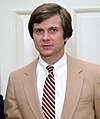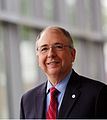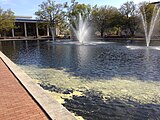 | |
Former names | South Carolina College (1801–1865; 1882–1887; 1890–1905) University of South Carolina (1866–1877)[1] South Carolina College of Agriculture and Mechanics (1880–1881)[2] |
|---|---|
| Motto | Emollit mores nec sinit esse feros (Latin) |
Motto in English | "Learning humanizes character and does not permit it to be cruel" (Ovid) |
| Type | Public research university |
| Established | December 19, 1801 |
Parent institution | University of South Carolina System |
| Accreditation | SACS |
Academic affiliations | |
| Endowment | $989 million (2021)[3] |
| President | Michael Amiridis |
| Provost | Donna K. Arnett |
Academic staff | 1,604 |
| Students | 35,364 (Columbia) 52,633 (System-wide)[4] |
| Location | , , United States |
| Campus | Midsize City, 359 acres (145 ha) |
| Newspaper | The Daily Gamecock |
| Colors | Garnet and black[5] |
| Nickname | Gamecocks |
Sporting affiliations | NCAA Division I FBS – SEC |
| Mascot | Cocky |
| Website | www |
The University of South Carolina (USC, South Carolina, or Carolina) is a public research university in Columbia, South Carolina. It is the flagship of the University of South Carolina System and the largest university in the state by enrollment. Its main campus is on over 359 acres (145 ha) in downtown Columbia, close to the South Carolina State House. The university is classified among "R1: Doctoral Universities with Highest Research Activity".[6] It houses the largest collection of Robert Burns and Scottish literature materials outside Scotland and the world's largest Ernest Hemingway collection.
Founded in 1801 as South Carolina College, USC now offers more than 350 programs of study, leading to bachelor's, master's, and doctoral degrees from 14 degree-granting colleges and schools. The university system has a total enrollment of approximately 52,000 students, with over 35,000 on the Columbia research campus as of fall 2019, making it the largest university in South Carolina. Professional schools on the Columbia campus include business, engineering, law, medicine, pharmacy, and social work.
History
[edit]Foundation and early history
[edit]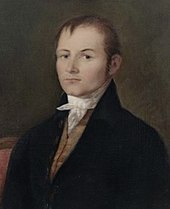
The university was founded as South Carolina College on December 19, 1801, by an act of the South Carolina General Assembly initiated by Governor John Drayton in an effort to promote harmony between the Lowcountry and the Backcountry. On January 10, 1805, having an initial enrollment of nine students, the college commenced classes with a traditional classical curriculum. The first president was the Baptist minister and theologian Reverend Jonathan Maxcy. He was an alumnus of Brown University, with an honorary degree from Harvard University. Before coming to the college, Maxcy had served as the second president of Brown and the third president of Union College. Maxcy's tenure lasted from 1804 through 1820.[7]

When South Carolina College opened its doors in 1805, the building now known as Rutledge College was the only building on campus. Located one block southeast of the State Capitol, it served as an administrative office, academic building, residence hall, and chapel. However, the master plan for the original campus called for a total of eleven buildings, all facing a large lush gathering area. In 1807, the original President's House was the next building to be erected. The building now known as DeSaussure College followed shortly thereafter, and the remaining eight buildings were constructed over the next several decades. When completed, all eleven buildings formed a U-shape open to Sumter Street. This modified quadrangle became known as the Horseshoe.
As with other southern universities in the antebellum period, the most important organizations for students were the two literary societies, the Clariosophic Society and the Euphradian Society.[8] These two societies, which arose from a split in an earlier literary society known as the Philomathic, grew to encapsulate the majority of the student body from the 1820s onward.
The college became a symbol of the South in the antebellum period as its graduates were on the forefront of secession from the Union. With the generous support of the General Assembly, South Carolina College acquired a reputation as the leading institution of the South and attracted several noteworthy scholars, including Francis Lieber, Thomas Cooper, and Joseph LeConte.
Slavery and slave labor played a fundamental role in the foundation and construction of the University of South Carolina. Many of the primary buildings in the central heart of campus, known today as the horseshoe, were built not only by slave labor but also of slave-made brick. Slave labor played a large role in the maintenance operational duties of early campus activities. This includes maintenance, cleaning of student tenements and faculty duplexes, and the preparation of meals.[9]
Civil War and reconstruction
[edit]Seventy-two students were present for classes in January 1862 and the college functioned until a call by the Confederate government for South Carolina to fill its quota of 18,000 soldiers. A system of conscription began on March 20 for all men between the ages of 18 and 45, but many students volunteered.[10] With the depletion of students, professors issued a notice that the college would open to those under 18 years old. Nine students showed up for class.
The University Act of 1869 reorganized the university and provided it with generous financial support. An amendment was added to the act by W. J. Whipper, a black representative from Beaufort, that would prevent racial discrimination from the admissions policy of the university. The legislature further proved its seriousness towards racial equality by electing two black trustees, Benjamin A. Boseman (misspelled as "Bozeman" in the bill) and Francis Lewis Cardozo,[11] to the governing board of the university on March 9, 1869. A normal school was established by the legislature on the campus of the university as well as a preparatory school for black students, since most former slaves were ill-prepared for academic work. In addition, to encourage enrollment by blacks, tuition and other fees were abolished. On October 7, 1873, Henry E. Hayne, the Secretary of State of South Carolina, became the first black student when he registered for the fall session in the medical college of the university.[12][13]
In 1877 South Carolina state leaders closed the university. It was reopened in 1880 as an white only agricultural college.[14]
Previous institution names
[edit]- Chartered as South Carolina College on December 19, 1801[15]
- Chartered as the University of South Carolina on January 10, 1866[16][17][1]
- Chartered as South Carolina College of Agriculture and Mechanics on October 3, 1880[18]
- Chartered as South Carolina College in 1882[19]
- Chartered as the University of South Carolina on May 9, 1888[20]
- Chartered as South Carolina College on April 21, 1890[21]
- Chartered as the University of South Carolina on February 17, 1906[22]
Campus
[edit]
The Horseshoe is listed on the National Register of Historic Places, and most of its buildings reflect the federal style of architecture in vogue in the early days of the nation. Among them is the South Caroliniana Library, which was designed by Robert Mills and is the first freestanding academic library in the United States.[23]
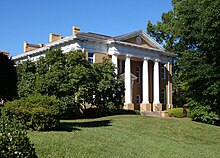
Over the years the 11 original buildings on the Horseshoe survived a fire, an earthquake, and the Civil War, but in 1939 McKissick Museum replaced the original President's House. The President's House would eventually return to the Horseshoe after extensive remodeling of one of its original buildings, which was dedicated as such in 1952.
During the 20th century: the campus began to spread out dramatically from the Horseshoe. Today it includes the student union, 24 residence halls, numerous academic buildings, Longstreet Theatre, the Koger Center for the Arts, the Carolina Coliseum, the Colonial Life Arena, Carolina Stadium, and various facilities for Olympic sports. (Williams-Brice Stadium is located approximately one mile off campus.) Recent additions to the campus are the Strom Thurmond Wellness and Fitness Center, the Greek Village, the Green Quad, the Honors College Residence Hall, the Public Health Research Center, the Graduate Columbia hotel, the Colonial Life Arena and Carolina Stadium. In 2017, a new School of Law building opened on Senate Street, and the Darla Moore School of Business opened its new home at the corner of Assembly and Greene in 2014.[24]

The University of South Carolina operates a transit system called Carolina Shuttle which consists of 14 buses.[25] "Carolina Cab" offers students free rides from Five Points to their homes within 5 miles (8 km) of campus on weekends.[citation needed]
Academics
[edit]Colleges and Schools
[edit]
|
|
Undergraduate admissions
[edit]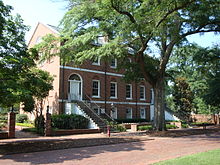
Undergraduate admissions are classified as more selective.[26] For the freshman enrollment of 2022, half the class had SAT scores between 1150 and 1360, or ACT scores between 26 and 31.[27]
South Carolina Honors College
[edit]Founded in 1978, the South Carolina Honors College offers support to academically gifted undergraduate students.[28][29] After gaining acceptance to the University of South Carolina, students must apply separately to the Honors College and demonstrate significant academic achievement. In 2019, entering freshmen had an average weighted GPA of 4.71 and a midrange SAT score (critical reading and math) of 1460–1530.[30]
Rankings
[edit]
|
| ||||||||||||||||||||||||||||||||||||||||||||||||||||||||||||||||||||||||||||||||||||||||||||
Research
[edit]The University of South Carolina is classified as a research institution of "very high research activity".[40] The university was awarded $278.6 million in research funding in the 2019 fiscal year, a record amount for the school and an increase of 8% over the year prior.[41]
During his tenure as president of the University of South Carolina, John Palms articulated a "Cathedrals of Excellence" budgeting philosophy. Palms advocated the money from fundraising be channeled into the school's best programs, rather than spread the funds evenly.[42] The strategy would pay off in the long term when these programs became nationally prominent, making a name for the University of South Carolina and attracting grant money.[43] His primary goal was for the university to be admitted to the Association of American Universities – an association of the leading 62 research universities in the United States and Canada.[42]

Former President Andrew Sorensen raised even larger sums for research, including a $300 million grant for colorectal cancer. In the spirit of Palms' budget, the board of directors moved to transform university land on Assembly Street into an "innovation district" called Innovista that will develop four areas: biomedicine, nanotechnology, environmental science and alternative fuels.
In May 2009, the University of South Carolina was selected by the U.S. Department of Energy as one of 31 universities nationwide to house an Energy Frontier Research Center that is expected to bring $12.5 million in federal funding, the largest single award in the university's history, to the College of Engineering and Computing. President Pastides commented on the grant, "This award solidifies the university's position as a leader in alternative-fuel research."[44]
The University of South Carolina is a member of the SEC Academic Consortium. Now renamed the SECU, the initiative was a collaborative endeavor designed to promote research, scholarship and achievement amongst the member universities in the Southeastern conference. The SECU formed its mission to serve as a means to bolster collaborative academic endeavors of Southeastern Conference universities. Its goals include highlighting the endeavors and achievements of SEC faculty, students and its universities and advancing the academic reputation of SEC universities.[45][46]
Student life
[edit]| Race and ethnicity[47] | Total | ||
|---|---|---|---|
| White | 75% | ||
| Black | 9% | ||
| Hispanic | 5% | ||
| Other[a] | 5% | ||
| Asian | 4% | ||
| Foreign national | 2% | ||
| Economic diversity | |||
| Low-income[b] | 18% | ||
| Affluent[c] | 82% | ||
Demographics
[edit]Over 34,500 [48] students attend the Columbia campus of the University of South Carolina, coming from all 46 South Carolina counties. In addition, students from all 50 states and more than 100 foreign countries are represented here. (Almost 16,000 students study at the regional campuses of the University of South Carolina System.)
Housing
[edit]
University Housing provides over 6,200 on-campus housing units. Rent includes all utilities.[49] Undergraduates may choose housing in a specific "living and learning community". The concept is to create a better social and learning environment by housing students with similar academic or career interests together.[50]
In the fall of 2004, the $29 million West Quad (now Green Quad) opened and became one of only four in the world to be certified by the U.S. Green Building Council's Leadership in Energy and Environmental Design (LEED) program. The 172,000-square-foot (16,000 m2) complex includes three four-story buildings.[51]
Since campus academic enrollment exceeds the capacity of on-campus housing, the university is adding more residence halls, most of which will be suite-style. As a result, some students live in popular off-campus housing.[52]
Student government
[edit]The university's student government is composed of the executive, judicial, and legislative branches. A 50-member Student Senate is led by the student body speaker of the Senate. The Student Senate enacts referendums, resolutions, and bills to enhance the student body in non-academic fields, maintains a budget for student life projects, confirms nominations for cabinet positions, and makes recommendations for change within the university. Their work is arranged according to the Student Government Constitution, a document written and adopted with the inception of student government and overseen by the President of the University of South Carolina and the university's board of trustees.
Media
[edit]
The Daily Gamecock is an editorially independent, daily student newspaper founded in 1908. It has a readership of more than 30,000 and is distributed across the University of South Carolina System.
The student run radio station, WUSC, began broadcasting on the AM dial in 1947. In January 1977 WUSC began broadcasting on the FM dial, and in 1982 the station found its current home at 90.5 FM. Since June 2006, WUSC is broadcasting in HD radio.[53]
Students publish a literary magazine, Garnet & Black, which was formed in 1994 as a consolidation of the university's former yearbook and its literary magazine. It is published four times a year and is free.[54]
The University of South Carolina established its first television station in the Fall 2006, Student Government Television (SGTV). It was funded by Student Government until April 2007 when Student Government released SGTV to the Department of Student Media, which also operates The Daily Gamecock, Garnet & Black Magazine and WUSC-FM. It was then that the station changed its name to it current name, Student Gamecock Television (SGTV).
Fraternities and sororities
[edit]About 22% of undergraduate men and 34% of undergraduate women participate in fraternities and sororities.[55] These Greek letter organizations are is governed by an internal body, the Greek Council. There are two separate councils, one for males and another for females.[56] Many of the fraternities and sororities have large, mostly Greek Revival style mansions; Lining Lincoln Street, Gadsden Street, and Mark Buyck Way are the houses referred to as the Greek Village.[57]
Recreation
[edit]Students tend to socialize off campus in Five Points and the Congaree Vista. Both of these areas are within walking distance of campus and offer restaurants, bars, cafés, and a variety of local entertainment.
Lake Murray and the three rivers (Saluda River, Broad River, and Congaree River) around Columbia offer students many recreational activities. The South Carolina coast—Charleston, SC, Myrtle Beach, Hilton Head—is only a 1.5- to 2-hour drive for additional recreational activities.
Athletics
[edit]

The university offers club, intramural, and varsity sports. Its 19 varsity sports teams compete in the Southeastern Conference (except for men's soccer which competes in the Sun Belt Conference and women's sand volleyball which competes as an independent) and are known as the Gamecocks.
Fight song
[edit]The university's band director James Pritchard obtained a band arrangement of the Elmer Bernstein-penned song "Step to the Rear" from the Broadway musical How Now, Dow Jones in 1968 and the marching band played the song at the first game of the 1968 season.[58] It caught the ear of Coach Paul Dietzel who contacted Pritchard about making it the official fight song of the university to replace the original "Carolina Fight Song" (or "Carolina Let Your Voices Ring," now called the "Old Fight Song").[58] Dietzel wrote the lyrics for the song, but asked that he remain anonymous because knowledge that the football coach wrote the lyrics might render it unacceptable to the basketball program.[58] The song was officially introduced on November 16, 1968, prior to the football game against Virginia Tech and has been the fight song since the Fall of 1969.[58]
Alma mater
[edit]The Gamecock reported in its March 1911 issue that very little progress had been made on the alma mater for the university despite a reward of $50 by the faculty. English professor, George A. Wauchope, took it upon himself and wrote the lyrics for the alma mater in 1911 set to the tune Flow Gently, Sweet Afton by Robert Burns. Other songs were written and sung, but Wauchope's song proved to be the most popular and it was adopted by the university in 1912.[59]
The tradition has developed that alumni raise their right hand as though raising a cup for the phrase "Here's A Health, Carolina" as if offering a toast.[60]
Notable people
[edit]Alumni
[edit]In 2017, the university reported having over 300,000 living alumni.[61]
-
Lee Atwater, MA 1977, Chair of the Republican National Committee
-
Stephen K. Benjamin, BA 1991 and JD 1994, 36th mayor of Columbia, South Carolina, Senior Advisor to the President
-
Andrew Card, BS 1971, U.S. Secretary of Transportation under George H. W. Bush, White House Chief of Staff under George W. Bush
-
Jadeveon Clowney, No. 1 pick in the 2014 NFL Draft
-
Alex English, BA 1976, 8-time NBA all star
-
Lindsey Graham, BA 1977, JD 1981, current U.S. Senator from South Carolina
-
Henry McMaster, BA 1969, JD 1973, current Governor of South Carolina
-
Alex Molinaroli, President and CEO of Johnson Controls, BS EE 1983, member of Interstate Batteries Board of Directors
-
Richard Riley, JD 1959, former Governor of South Carolina, 6th United States Secretary of Education
-
Darius Rucker, musician and lead vocalist, Hootie & the Blowfish
-
William Timmons, MA, JD, current U.S. representative for South Carolina's 4th congressional district
Presidents
[edit]During its more than two hundred-year history, the university has had 28 presidents. The board of trustees announced the selection of Robert L. Caslen as the 29th president on July 19, 2019. Caslen's predecessor, Harris Pastides, served as the university's president from 2008 until 2019. After Caslen abruptly resigned in May 2021, Pastides returned as the institution's interim president while a new search for a permanent president was launched.[62] Michael Amiridis, named 30th president on January 14, 2022, took office July 1, 2022.
Board of trustees
[edit]Since its charter in 1801, the university has been governed by a board of trustees, which now governs the entire University of South Carolina System.
Photo gallery
[edit]-
The Capstone Building
-
Flowers in front of Thomas Cooper Library
-
The fountain and pond in front of Thomas Cooper Library
See also
[edit]Notes
[edit]- ^ Other consists of Multiracial Americans & those who prefer to not say.
- ^ The percentage of students who received an income-based federal Pell grant intended for low-income students.
- ^ The percentage of students who are a part of the American middle class at the bare minimum.
References
[edit]- ^ a b Lesesne, Henry (June 28, 2016). "University of South Carolina". South Carolina Encyclopedia. University of South Carolina, Institute for Southern Studies. Retrieved February 25, 2021.
In 1866 state leaders revived the institution with ambitious plans for a diverse University of South Carolina.
- ^ Green, Edwin Luther. "The Third South Carolina College, 1891–1906." History of the University of South Carolina. The State Co., 1916, https://archive.org/details/historyofunivers00greerich/page/120/mode/2up.
- ^ "UofSC endowment sees record growth in fiscal year 2020-2021". University of South Carolina.
- ^ "About The University of South Carolina" (PDF). University of South Carolina. Retrieved October 31, 2017.
- ^ "Colors – Communications and Public Affairs | University of South Carolina". Retrieved July 16, 2019.
- ^ "Institutional Profile: University of South Carolina-Columbia". Carnegie Foundation for the Advancement of Teaching. Retrieved November 1, 2013.
- ^ "Interim President Harris Pastides | University of South Carolina". president.sc.edu. Archived from the original on March 7, 2009.
- ^ Durham, David (2008). A Southern Moderate in Radical Times: Henry Washington Hilliard, 1808–1892. Baton Rouge: LSU Press. p. 13. ISBN 978-0807133286.
- ^ "Slavery at South Carolina College, 1801–1865 – University of South Carolina Libraries". Delphi.tcl.sc.edu. Retrieved March 18, 2022.
- ^ Beach, Frederick Converse (1907). The Americana: A Universal Reference Library, Comprising the Arts and Sciences, Literature, History, Biography, Geography, Commerce, Etc., of the World. Vol. 14. Scientific American Compiling Department.
- ^ Brown, Loretta Costello (December 2, 1983). "USC celebrates 110 years of black presence". The Index–Journal (Greenwood, South Carolina). p. 9.
- ^ Reynolds, John S. (1969). Reconstruction in South Carolina. Negro University Press. p. 233.
- ^ Hollis, Daniel Walker (1956). "University of South Carolina". II. University of South Carolina Press: 66.
((cite journal)): Cite journal requires|journal=(help) - ^ "Timeline - University History | University of South Carolina".
- ^ Green, Edwin Luther. History of the University of South Carolina. The State Co., 1916, pp. 11, https://archive.org/details/historyofunivers00greerich/page/11/mode/2up.
- ^ Green, Edwin Luther. History of the University of South Carolina. The State Co., 1916, pp. 84, 87(line 14), 88, 94, https://archive.org/details/historyofunivers00greerich/page/87/mode/2up.
- ^ Green, Edwin Luther. “Chapter VII. The University of South Carolina, 1865–1873.” History of the University of South Carolina. The State Co., 1916
- ^ Green, Edwin Luther. History of the University of South Carolina. The State Co., 1916, pp. 99–100, https://archive.org/details/historyofunivers00greerich/page/99/mode/2up.
- ^ Green, Edwin Luther. History of the University of South Carolina. The State Co., 1916, pp. 103–104, https://archive.org/details/historyofunivers00greerich/page/103/mode/2up.
- ^ Green, Edwin Luther. History of the University of South Carolina. The State Co., 1916, pp. 111, https://archive.org/details/historyofunivers00greerich/page/111/mode/2up.
- ^ Green, Edwin Luther. History of the University of South Carolina. The State Co., 1916, pp. 120, https://archive.org/details/historyofunivers00greerich/page/120/mode/2up.
- ^ Green, Edwin Luther. History of the University of South Carolina. The State Co., 1916, pp. 129, https://archive.org/details/historyofunivers00greerich/page/129/mode/2up.
- ^ "About the South Caroliniana Library – University Libraries". University of South Carolina. Retrieved December 13, 2012.
- ^ "University of South Carolina - Highlights". www.sc.edu. Archived from the original on May 6, 2008.
- ^ "USC Vehicle Management & Parking Services". University of South Carolina. Retrieved December 13, 2012.
- ^ "Carnegie Classifications | Institution Lookup". carnegieclassifications.acenet.edu.
- ^ "University of South Carolina Admissions". US News Best Colleges. March 10, 2016. Retrieved August 13, 2023.
- ^ "SC Honors College – Office of Undergraduate Admissions – University of South Carolina". Retrieved August 15, 2016.
- ^ Roko, Ellyde (December 2, 2004). "New program at University of South Carolina targets top students". The State.
- ^ "Admitted Class Profile". University of South Carolina.
- ^ "Forbes America's Top Colleges List 2023". Forbes. Retrieved September 22, 2023.
- ^ "2023-2024 Best National Universities". U.S. News & World Report. Retrieved September 22, 2023.
- ^ "2023 National University Rankings". Washington Monthly. Retrieved February 10, 2024.
- ^ "2024 Best Colleges in the U.S." The Wall Street Journal/College Pulse. Retrieved January 27, 2024.
- ^ "ShanghaiRanking's 2023 Academic Ranking of World Universities". Shanghai Ranking Consultancy. Retrieved February 10, 2024.
- ^ "QS World University Rankings 2025: Top global universities". Quacquarelli Symonds. Retrieved June 6, 2024.
- ^ "World University Rankings 2024". Times Higher Education. Retrieved September 27, 2023.
- ^ "2022-23 Best Global Universities Rankings". U.S. News & World Report. Retrieved February 25, 2023.
- ^ "University of South Carolina Rankings". U.S. News & World Report. Retrieved October 3, 2020.
- ^ "Carnegie Classifications – Standard Listings". Retrieved August 15, 2016.
- ^ "UofSC Sets New Record with $278.6 Million in Research and Sponsored Awards Funding". Archived from the original on September 5, 2015. Retrieved May 16, 2020.
- ^ a b Lesesne, Henry H. (2001). A History of the University of South Carolina, 1940–2000. University of South Carolina Press. p. 331.
- ^ Lesesne, Henry H. (2001). A History of the University of South Carolina, 1940–2000. University of South Carolina Press. p. 332.
- ^ "Record award to create Energy Frontier Research Center". University of South Carolina. Retrieved December 13, 2012.
- ^ "SECU". SEC. Retrieved February 13, 2013.
- ^ "SECU: The Academic Initiative of the SEC". SEC Digital Network. Retrieved February 13, 2013.
- ^ "College Scorecard: University of South Carolina-Columbia". United States Department of Education. Retrieved May 8, 2022.
- ^ sc.edu
- ^ "Apartment Style Description". Housing.sc.edu. Retrieved January 21, 2013.
- ^ "Housing - Housing | University of South Carolina". sc.edu. Archived from the original on March 27, 2009.
- ^ "Housing - Housing | University of South Carolina". sc.edu. Archived from the original on August 8, 2007.
- ^ "USC Institutional Assessment and Compliance". Ipr.sc.edu. Retrieved January 21, 2013.
- ^ "About WUSC". Wusc.sc.edu. Retrieved January 21, 2013.
- ^ "Student Media - Student Affairs and Academic Support | University of South Carolina". www.sc.edu. Archived from the original on May 6, 2008.
- ^ "University of South Carolina Student Life". US News Best Colleges. June 16, 2014. Retrieved August 13, 2023.
- ^ "USC Greek Life". Sa.sc.edu. October 11, 2012. Archived from the original on October 2, 2011. Retrieved January 21, 2013.
- ^ "USC Greek Housing". Sa.sc.edu. October 11, 2012. Archived from the original on October 2, 2011. Retrieved January 21, 2013.
- ^ a b c d The Carolina Bands Collection: Series I: Sheet Music (1914-2000s): 1/12 "Step to the Rear." The Music Library at the University of South Carolina website. Retrieved December 1, 2009.
- ^ "USC: Office of the University Registrar: A University Tradition". Registrar.sc.edu. Retrieved January 21, 2013.
- ^ "USC: Alma Mater". Sc.edu. Retrieved January 21, 2013.
- ^ Wilks, Avery (March 24, 2017). "Out-of-state students double at USC". The State. Retrieved August 29, 2020.
- ^ Marchant, Bristow; Daprile, Lucas (May 12, 2021). "USC President Robert Caslen has resigned, Pastides to serve in interim role". The State. Retrieved May 13, 2021.
Further reading
[edit]- Hollis, Daniel Walker, (1951) University of South Carolina Volume I South Carolina College, Columbia: University of South Carolina Press
- Hollis, Daniel Walker, (1956) University of South Carolina Volume II College to University Columbia: University of South Carolina Press
- Sugrue, Michael, (1992) South Carolina College: The education of an antebellum elite. Dissertation
External links
[edit]- Official website

- South Carolina Athletics website
- . Collier's New Encyclopedia. 1921.
- . . 1914.
- . New International Encyclopedia. 1905.
Located in: Columbia, South Carolina | |||||||||
| Academics | |||||||||
| Athletics |
| ||||||||
| Campus | |||||||||
| Student life | |||||||||
| Miscellaneous | |||||||||
| |||||||||
| International | |
|---|---|
| National | |
| Geographic | |
| Academics | |
| Artists | |
| People | |
| Other | |
